New and remodeled recreation facilities have a lot to say ooh and aah about: colors and state of the art equipment, space and plush locker rooms, technology and furniture. Meanwhile, the surfaces that are walked on and run on, that spread impact and dampen noise, that return bounces and are palettes for logos and navigation, are easier to overlook but just as important.
Manufacturers today take advantage of modern materials to provide either specialized or multi-use surfaces for every kind of activity. Modular surfaces make flexibility, scalability, and replacement easier, artificial turf has long been for indoor uses that have expanded to fitness areas as well as playing areas, and cushioning advancements fit everything from gymnastics to wrestling to weightlifting spaces.
A quick look at any supplier’s description of sports flooring options makes it clear that physics and data are the norm, with a variety of thicknesses, and information on energy restitution, force reduction, durability, slip resistance, and more, along with some suggestions for the most appropriate sports or activities, like aerobics, high-intensity training, heavy workout equipment and weights, basketball, volleyball, and other sports.

Also essential to modern flooring is a dedication to helping the earth, said Wil Younger, marketing manager for a Lebanon, Pa.-based company that was a pioneer in using recycled materials. Younger said when his company began 70 years ago, recycled rubber flooring was a new concept, primarily repurposing scrap materials for basic durability, impact absorption, and sound dampening.
Evolution for Younger’s company and others in the surface business isn’t limited to environmental responsibility and materials innovation. Younger said in his company’s case, performance has also progressed dramatically.
“Early recycled rubber flooring provided basic shock absorption, but today, we engineer our products for specific applications,” he said. “Our flooring solutions offer optimized energy restitution, force reduction, and sound dampening, making them ideal for everything from recreational group fitness spaces to performance weightlifting platforms and high-intensity training zones. We’ve introduced multi-layered systems that provide resilience and comfort, reducing the risk of injury and enhancing athletic performance.”
Aesthetics and customization have also come a long way, said Younger. Originally, recycled rubber flooring was only available in limited colors and finishes, but today, there’s a wide range of color blends, inlaid logos, and textured surfaces to match any facility’s branding and design needs.
“We understand that performance is key, but so is supporting your brand and creating an inspiring space for athletes and fitness enthusiasts,” he said.
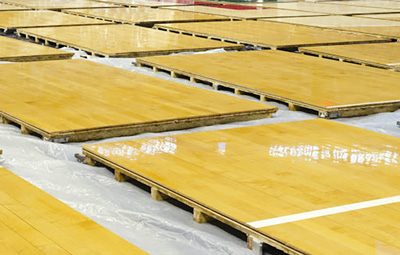
Iannick Di Sanza, director of marketing for a supplier of multipurpose flooring, said the trend toward responsible materials is not just to benefit the environment but also the user. Many of his company’s products incorporate recycled content, low-VOC materials, phthalate-free manufacturing, are asthma and allergy friendly, and have earned leading certifications like USDA Biopreferred, GreenGuard Gold, FloorScore.
Di Sanza said that other than sustainability, a strong trend in the industry has been the move toward materials suited to multi-use facilities that have added social gatherings to athletic and recreational pursuits.
“There has been a clear shift from traditional hardwood courts to high-performance sports vinyl flooring, driven by the need for multi-use functionality, durability, and lower maintenance costs,” he said. “While hardwood remains a classic choice for basketball, sports vinyl provides similar ball response and shock absorption while being more resilient to wear, easier to clean, and better suited for facilities hosting multiple activities—from sports to community events.”
With many needs, organizations and businesses need to do a little homework before calling around for flooring help, Di Sanza said. Before you start looking, consider the following:
- Facility Usage: What sports or non-athletic activities will the floor be used for?
- Equipment: What type of equipment is planned to be used on the floor—tables and chairs, portable or telescopic bleachers, stages, etc.?
- Performance Needs: Is the venue for a high-level athletics program or recreation?
- Aesthetic Preferences: Are there specific colors, logos, or branding requirements?
- Budget and Timeline: Understanding financial and scheduling constraints helps in selecting the best solution.
Maintenance Expectations: What are the current maintenance expectations and capacity requirements?
Di Sanza’s list of what affects pricing is likely the same for all suppliers:
- Project Customization: As every venue is unique, material quantity, logos, and unique colors have an impact.
- Location: The site location, state regulations, surface size, and scheduling calendar/complexity can also affect pricing.
- Installation: Costs vary based on subfloor preparation, moisture mitigation, and facility requirements.
- System Design: Product specifications, class certification, thickness, format, and system technology can impact the cost.
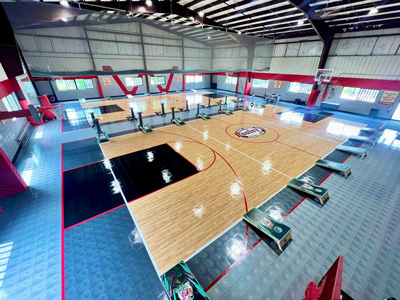
The modularity offered by some companies solves issues like installation difficulties as well as the ability to add more when and if there’s expansion, said Jake Angrisano, a sales representative for a Utica, N.Y-based company that supplies modular sports, fitness, and other surfacing.
Angrisano said his company’s product is most valuable as a no-muss, no-fuss alternative, especially when refreshing or remodeling. Lines can be pre-painted on the tiles, or the company can supply DIY painting kits, said Angrisano.
“Our products are excellent for helping clients transform existing spaces into an area that looks and feels brand new with minimal construction efforts,” said Angrisano. “We frequently install our materials over existing concrete and asphalt pads that have seen better days, and by doing so we can help to breathe new life into and extend the lifespan of a space that has already been around for years.”
Another modular flooring supplier based in Salt Lake City, Utah, said one more advantage of this type of surfacing is ease of care. “(Our) surfaces require minimal cleaning and maintenance, and never need to be recoated,” said Stephanie Corrigan, director of brand and product marketing. “In-house maintenance teams can provide mopping and cleaning of the surface with materials already on hand. Each [installer] can also provide a more detailed periodic cleaning and maintenance program customized to each specific sites’ needs.”
Customizability is the way a third modular flooring company sells itself. “Serving clients worldwide and in many industries, (our) team recognized that in sport surfacing, one size does not always fit all, with different sports having specific needs for ball response, athlete performance, and varied other expectations for their floor,” said Lauren Christenson, vice president of sales and marketing.
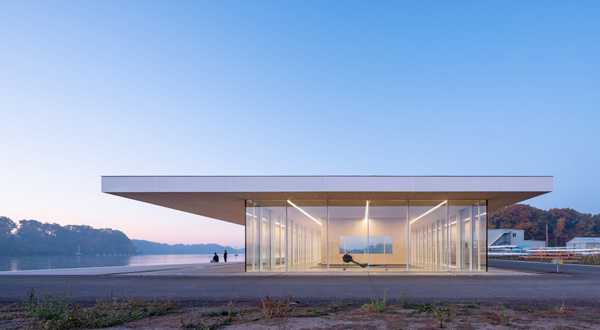
Many of the options for facilities, homeowners, and businesses are marketed as budget-conscious. Not so the granddaddy of sports courts, the hardwood floor. It has different pricing based on the grade of the wood used and the subflooring desired; grade schools do not need the same subfloor as professional basketball, for instance, said Maple Flooring Manufacturing Association (MFMA) Executive Vice President Steve Barnard.
Wooden flooring does need more care and greater attention to detail before installation, but its main edge over alternatives is its longevity—75 to 80 years if maintained properly, said Barnard.
“MFMA maple, beech, and birch flooring is superior to other flooring options because of its performance, quality, sustainability, and cost,” said Barnard. “The flooring itself hasn’t changed much over the past 125-plus years. What has changed is the number and complexity of subfloor systems.”
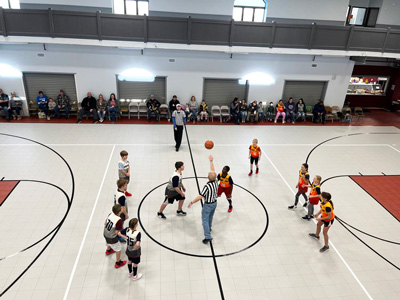
Wood floors are striking, but that beauty comes with more preparation and maintenance than alternatives, said Barnard. That work is balanced by the confidence provided by the strict quality controls of the MFMA:
- Floor systems are available that meet international standards for safety and product performance; MFMA flooring is the choice of every National Basketball Association team.
- The MFMA grading rules and (performance) standards ensure the maple flooring installed looks and performs per specifications.
- The MFMA inspects each mill on a quarterly basis to ensure compliance with grading rules.
MFMA maple is naturally sustainable. Most MFMA member mills are chain-of-custody certified to provide Forest Stewardship Council (FSC) certified flooring. Hardwoods require less fossil carbon for production than alternatives.
Those mulling a wood floor must be armed with plenty of information before contacting a flooring partner, said Barnard. It is good practice to schedule a site evaluation with the general contractor and architect/owner prior to commencement of any maple flooring installation, Barnard said. Important considerations before installation include:
- A stable environment to be maintained throughout the lifetime of the floor.
- All roof work should be completed, including flashing, guttering, and exterior drainage.
- The building must be permanently enclosed and weather-tight.
Concrete flatness and moisture content must meet the requirements detailed in MFMA Position Statements Concrete Slab Moisture Content and Concrete Slab Flatness.
- All interior painting must be completed and dry.
- The permanent light, heating, electrical, and ventilation systems must be operating.
- All overhead work must be complete, and the floor area must be free of obstructions.
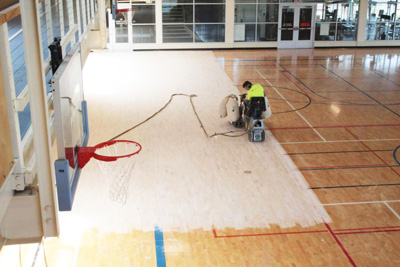
All backstops and sports accessory fixtures must be installed.
Once installed, there is daily cleaning, annual maintenance and refinishing, and resurfacing to ensure the long life of the flooring, said Barnard. Facility use, abuse, and maintenance will determine the appropriate refinishing schedule. Most gymnasium floors should be recoated annually.
A complete resurfacing is accomplished by first removing all layers of finish and game lines down to raw wood, said Barnard. Next, repair/replace any split boards or seriously damaged areas of the surface or subfloor. The maple surface is then ready to be lightly sanded to remove accumulated minor dents and scratches.
Once the sanding process is completed, the resurfacing process follows the same general sealing, court lining, and finishing procedures used during the initial installation of the maple flooring system.
“From time to time, even the most meticulously cared for maple gymnasium floor should receive a complete resurfacing,” Barnard said. “Resurfacing restores the luster in an older gymnasium surface and ensures long life and excellent performance. The frequency of complete resurfacing is dependent on many factors but typically is performed about every eight to 10 years.” RM

